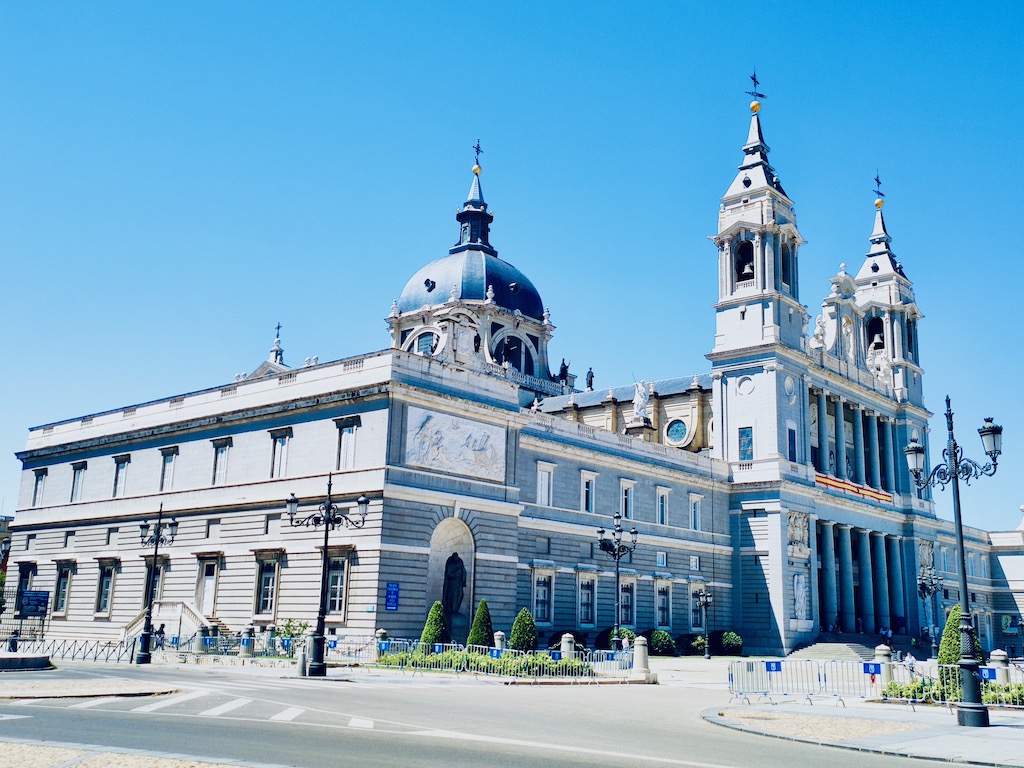

Looking up at the Almudena Cathedral, a question came to my mind. What’s the origin of the name of the cathedral? I couldn’t find a literal translation. But after some research, I finally found out where the name came from. “Almudena” is a Spanish word originating from the Arabic “al-mudayna” which means citadel. The Royal Palace and the Cathedral are now located here where the ancient Muslim citadel once stood a long time ago. visit madrid.
The history of the Almudena Cathedral visit madrid.
The history of the Almudena Cathedral began in 1868. The Congregation of “Our Lady of Almudena” then asked the Archbishop of Toledo for permission to build a new church dedicated to their Virgin. The country was in the middle of a revolution, and the old place of worship has just been destroyed. The Archbishop accepted the request. On top of that, thanks to the mediation of Queen Maria de las Mercedes of Orleans, a devotee of the “Virgin of Almudena,” the royal house ceded some land in front of the royal palace. Two other unexpected events occurred which will precipitate this decision: the premature death of the queen in 1878 and the decision of King Alfonso XII to make this new church the burial place of his late wife.
The start of the construction
The King ordered the construction of the church. Architect Francisco de Cubas drew up the first plans for the church in 1879, with the aim of creating a pantheon for the Queen. In 1883, King Alfonso XII laid the first stone.
A major change took place
Building work progressed until a papal bull issued by Leo XIII stopped them. Indeed, in 1885, he established Madrid as a diocese with the aim of creating the bishopric of Madrid-Alcalá. Therefore, Francisco de Cubas had to rethink the plans because the church must now become a cathedral.
He then began a new project more ambitious than the previous one. This time, he took inspiration from the 18th century French Gothic. He added structural elements from the French cathedrals of Reims and Chartres, as well as the Spanish cathedral of León. Finally, he included a large Roman crypt in the ensemble. However, the donations were insufficient and the construction suffered many delays.
In 1899, 16 years after the beginning of the building work, Francisco de Cubas died. Three architects then took over: Miguel Olabarría, Enrique Maria Repullés, and Juan Moya.
In 1911, the crypt was finished and opened to the public. Construction work for the rest of the building continued until the outbreak of the civil war, during which it was suspended.
When they resumed in 1939, with limited resources, the aesthetic criteria of the time were no longer relevant. The cathedral no longer fit in with its surroundings. The architects had to rethink the plans one more time. One of the major changes was to lower its height to make it more in tune with the royal palace.
The cloister, which the plans have been unchanged, was completed in 1955. For the main facade, new arrangements were made and it took five more years to finish it. It was ultimately completed in 1960.
110 years later, it’s the end of construction
In 1993, the construction was brought to an end. A few months later, on June 15, the cathedral was consecrated by Pope John Paul II on his fourth trip to Spain.
However, the cathedral remained unfinished. To this day, it continually requires a lot of finishing and enhancement work to make it as beautiful as it is now.
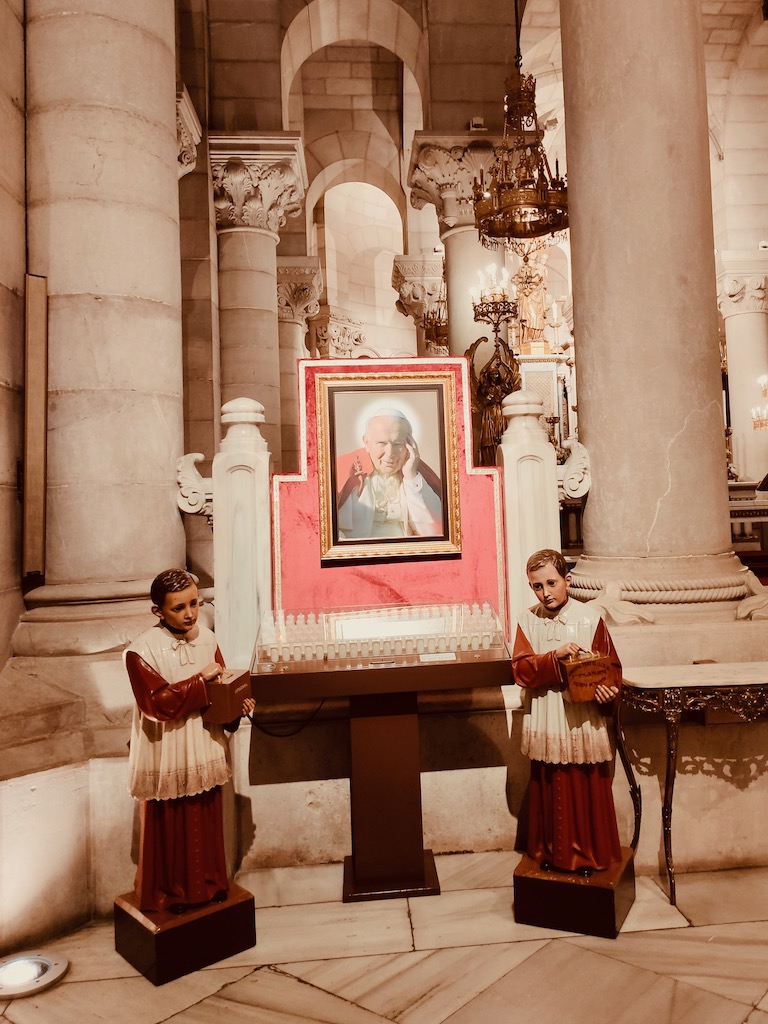

Visit of the Almudena Cathedral
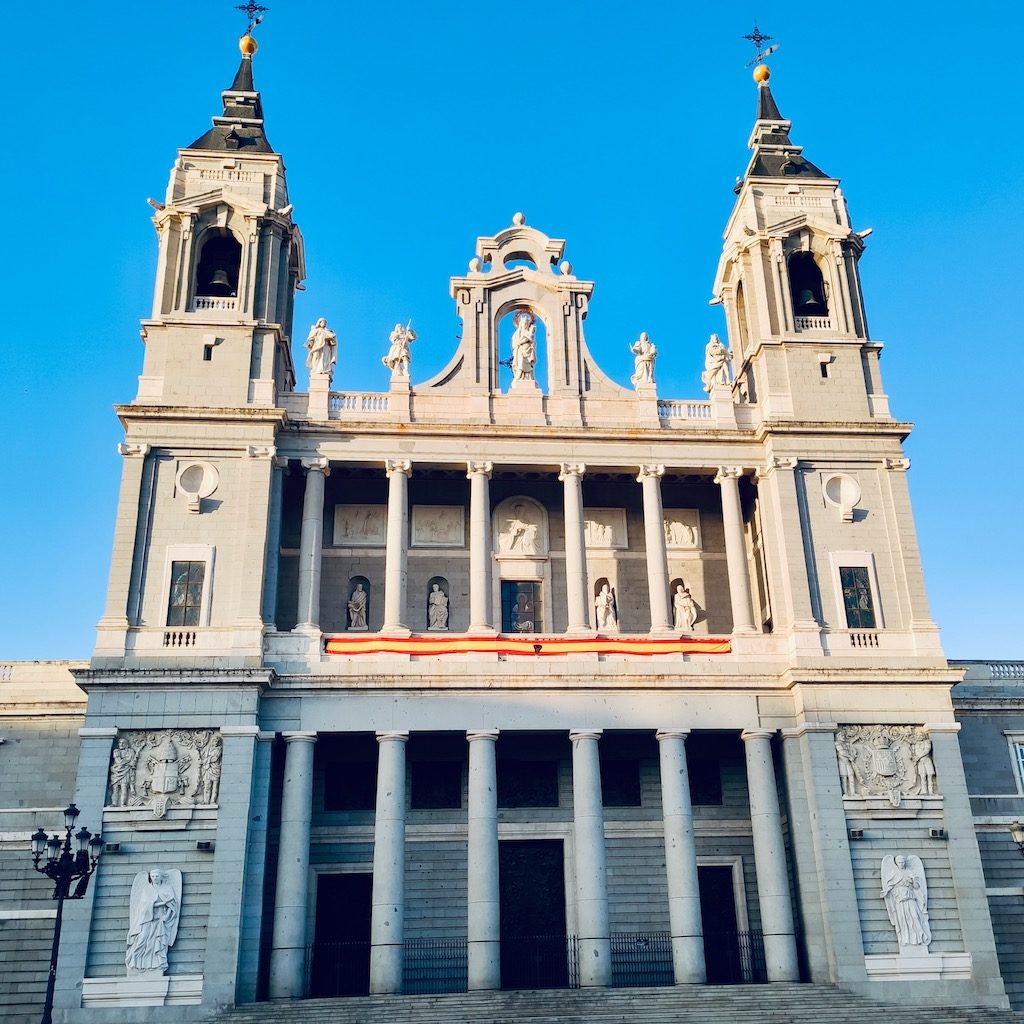

The main entrance is northbound. In fact, unlike the east-west orientation of the other cathedrals, it was built on a north-south axis. And the reason is simple. The palace and the cathedral complex have to be harmonious!
Among the beautification work was the renovation in 2000 of the cathedral gates. The cardinal of Madrid commissioned the Spanish sculptor Luis Antonio Sanguino for this project. They were redone in bronze with a Pompeian green patina. He decorated them with themes about the Trinity and references to the Spanish Catholic monarchy.
The main one is the “Gate of the Holy Trinity.” The embellishments in the upper part of the gate represent the Mystery of the Holy Trinity with the Father, the Son, and the Holy Spirit.
Another entrance is situated on the east side of the cathedral, with three majestic doors styled in the same way.
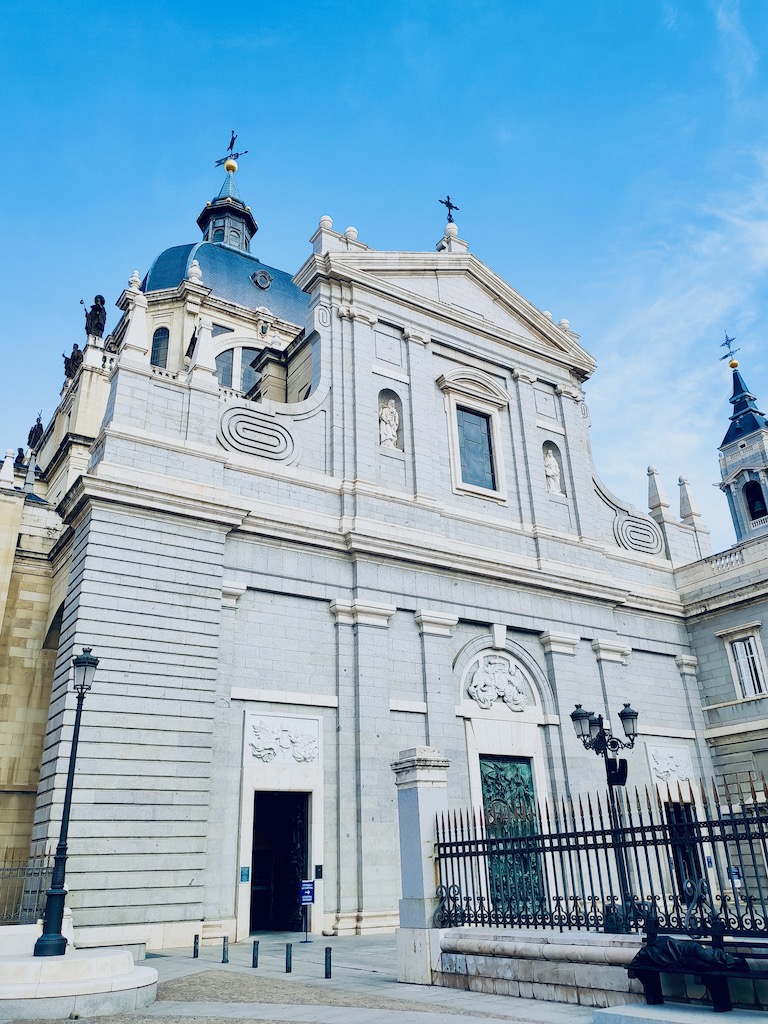

The central gate is the “Cathedral’s Gate of Consecration.“ One can see Pope John Paul II in the presence of Cardinal Suquia and Their Majesties, the kings of Spain.
The two side doors show the Virgin Of Our Lady of Almudena and the Blessed Virgin blessing Madrid.
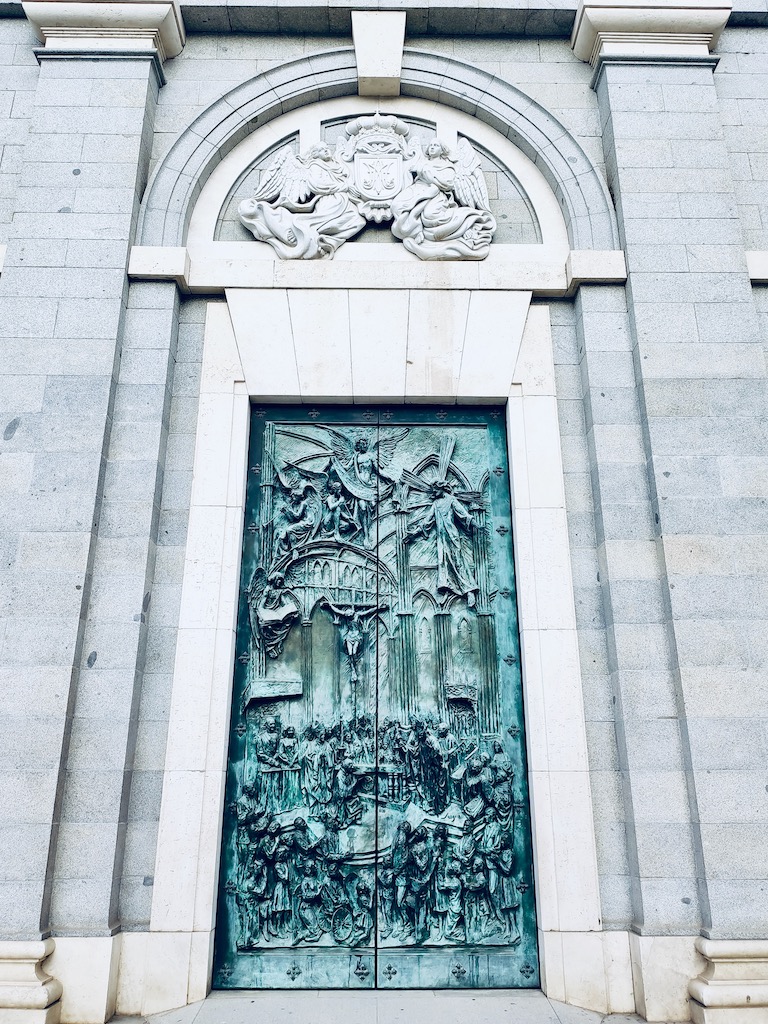

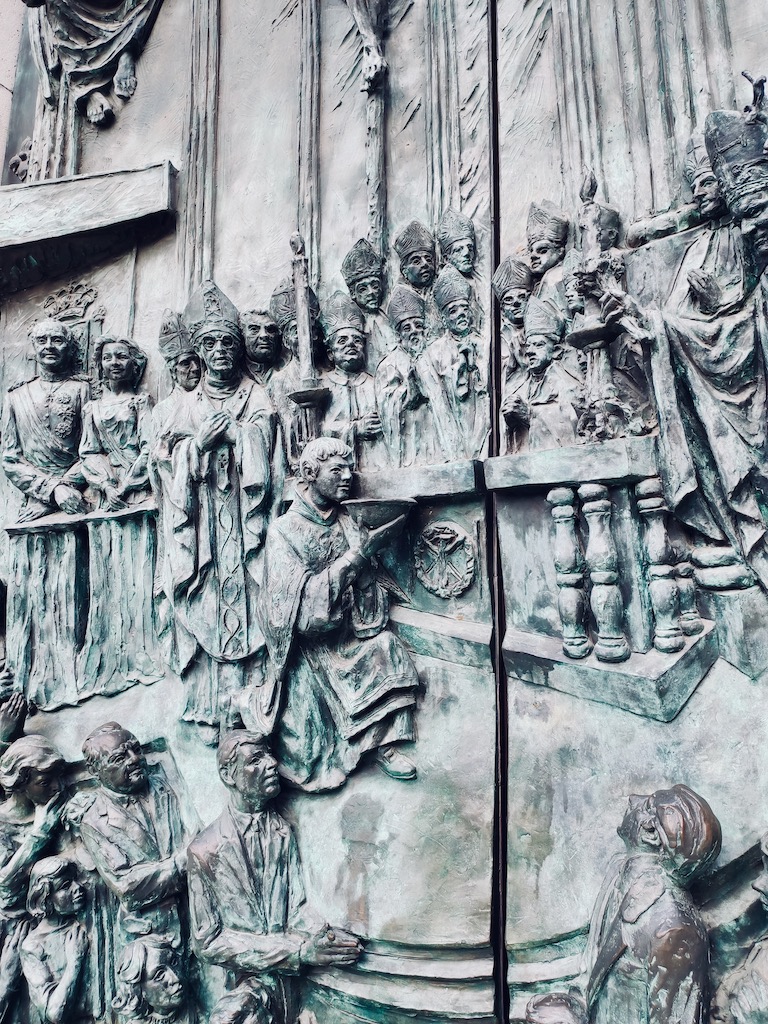

The sanctuary
We entered the cathedral and were in awe. It is strikingly colorful and contrasts with the more austere cathedrals that we are used to visiting.
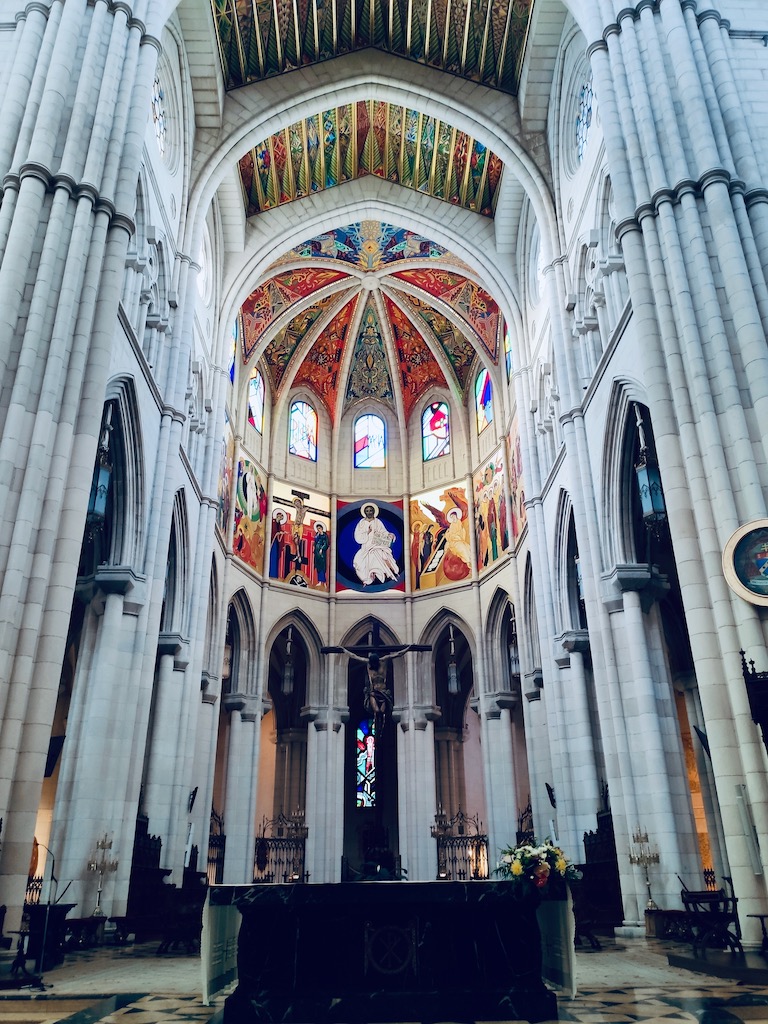

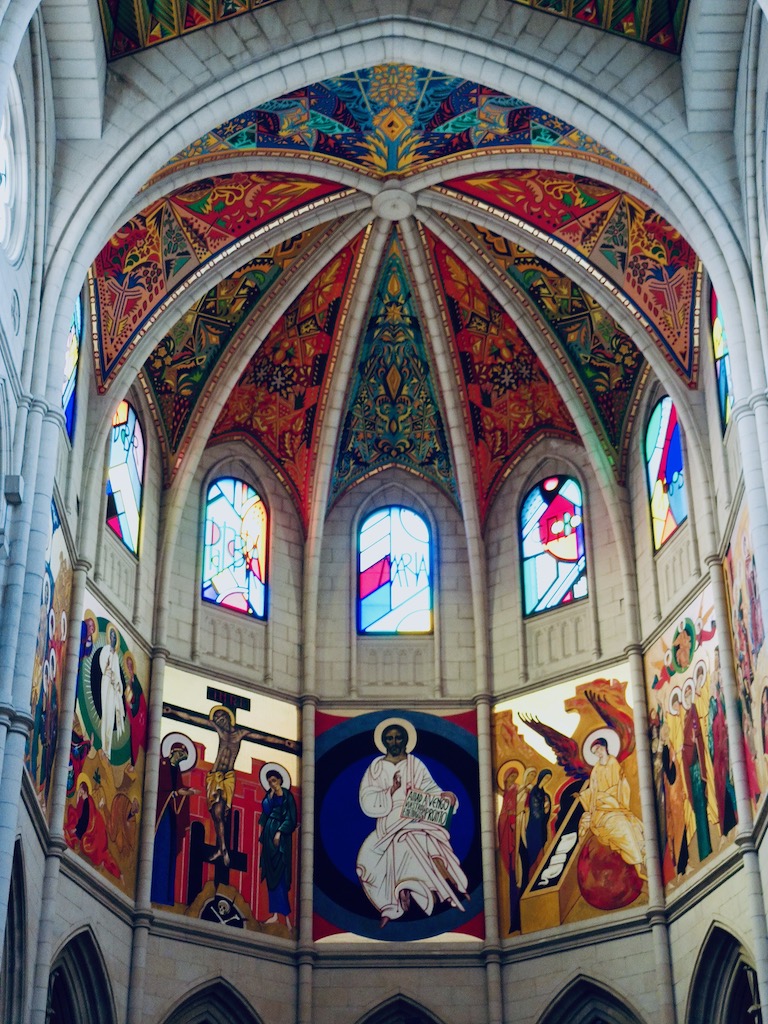

The sanctuary is beautiful. At the top is a vibrant fresco presenting the seven mysteries of our Salvation: the baptism of Jesus, transfiguration, death, resurrection, ascension to heaven, and Pentecost.
We continued on our way and discovered a small chapel to the right of the sanctuary. Fortunately, there was no one in the cathedral but us. For me, it is a much more pleasant experience to visit a holy place in a solemn atmosphere than a noisy one.visit madrid
The Chapel of the Blessed Sacrament
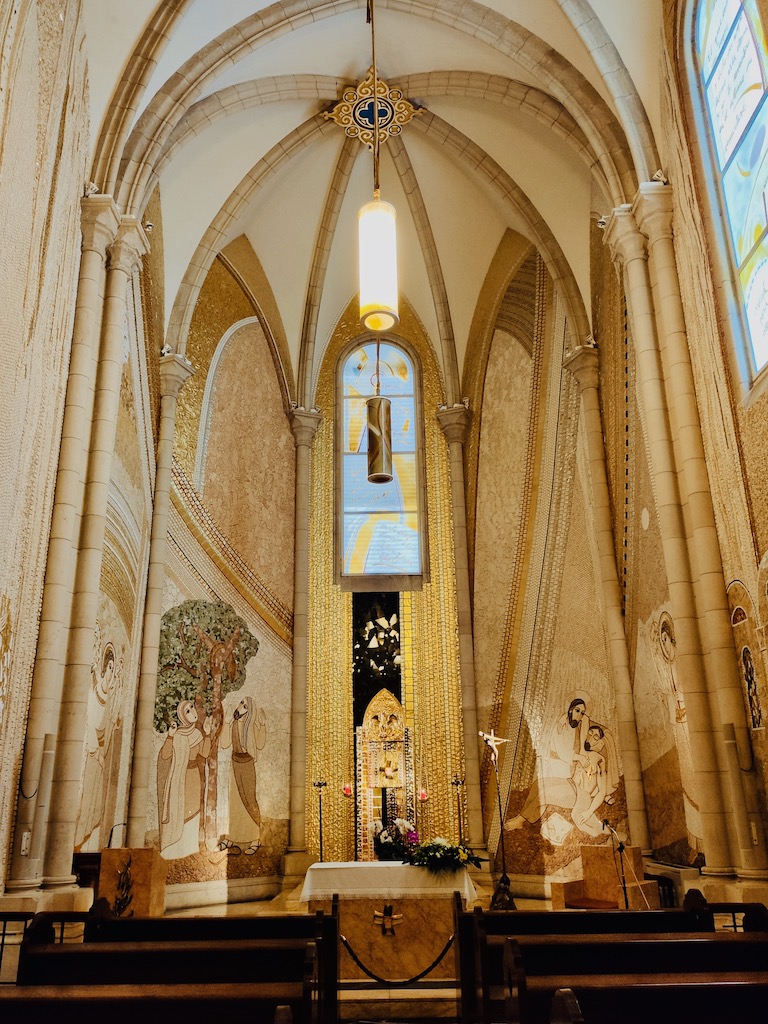

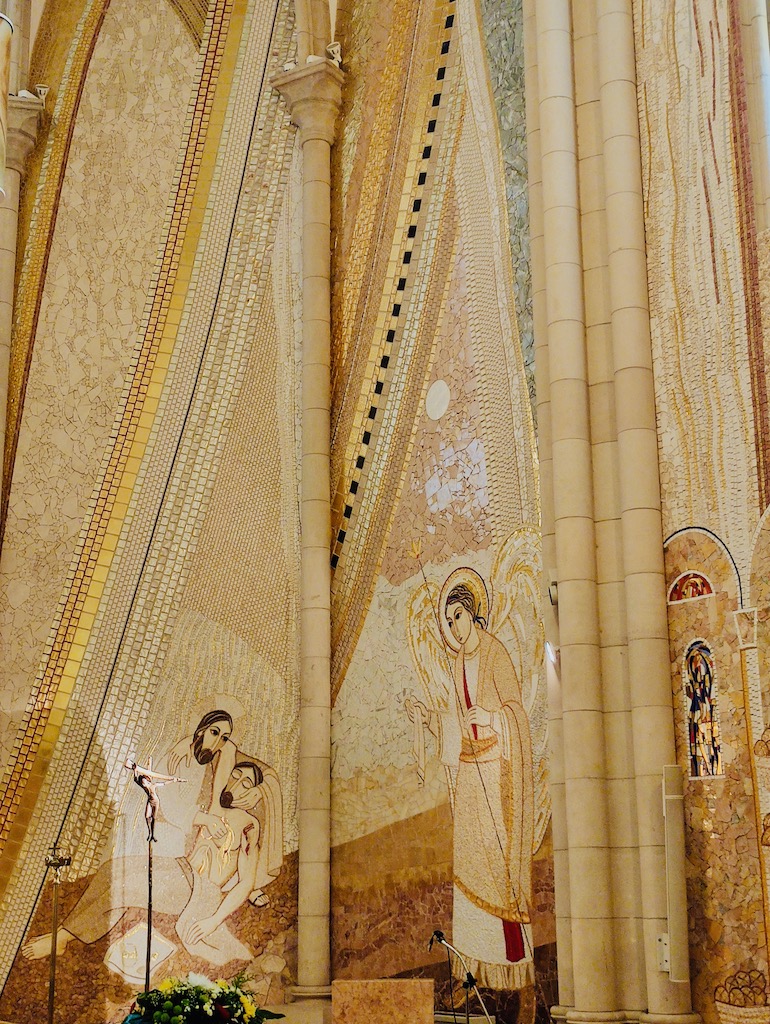

In contrast with the vibrant colors of the sanctuary, inside the chapel the tones are softer with shades of ochre and gold. It was completely redecorated with mosaics in 2011 by Father Ivan Marko Rupnik, a Slovenian Jesuit priest and theologian artist. He is the head of the art workshop at the “Aletti Centre” in Rome.
The beauty of the mosaics, the warmth of the tones give this chapel a truly relaxing atmosphere. We stayed here for a little while to admire the artistry.
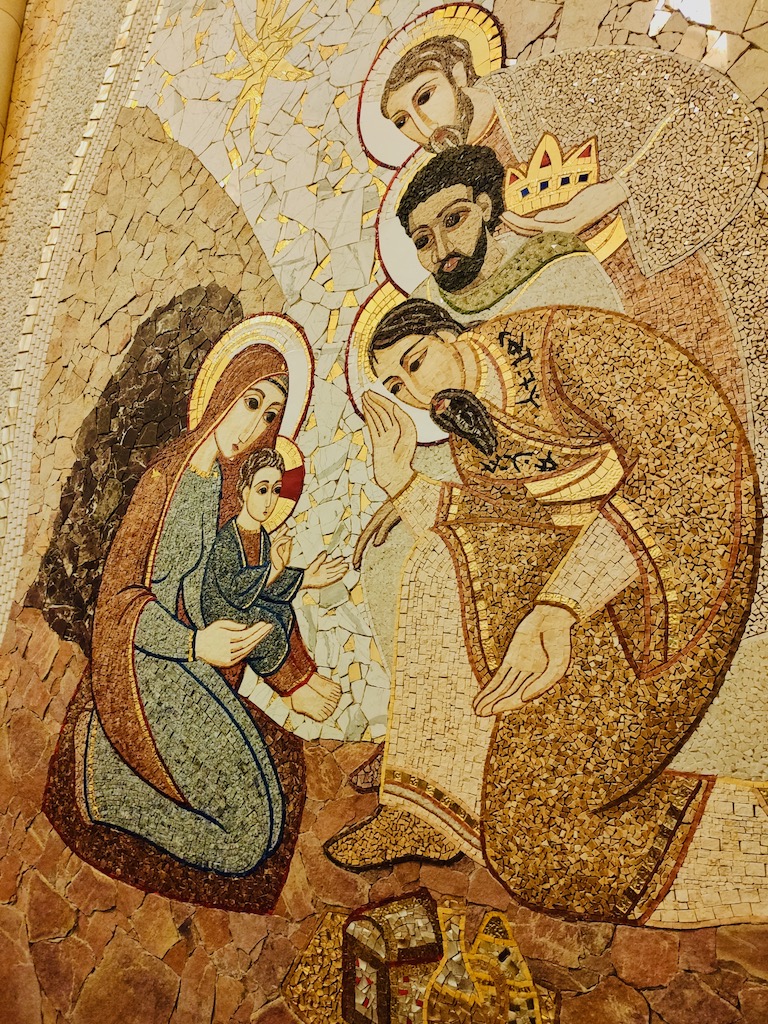

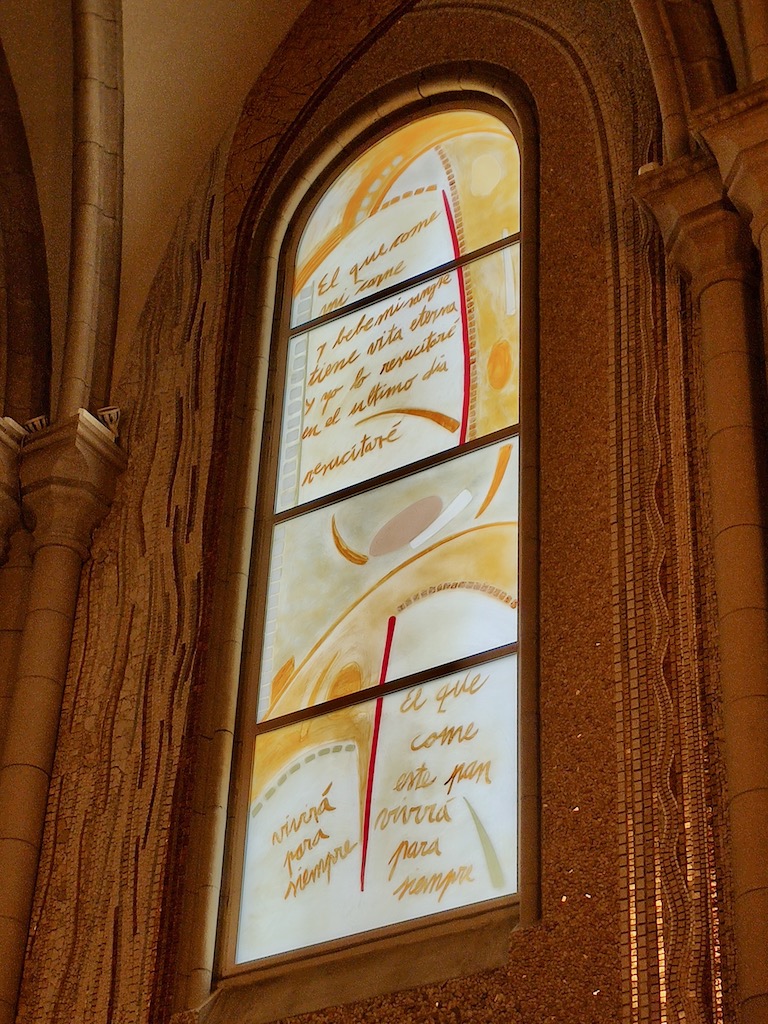

Back in the nave, we arrived in the transept facing a funerary chapel above which is a bright and impressive ensemble.
“Ascension to the Virgin”
The funerary chapel belongs to Queen Maria de las Mercedes d’Orléans. In November 2000, the church brought her remains here in accordance with the wishes of her husband King Alfonso XII. That was 122 years after the initial request!
Above is a statue of the virgin depicting her as queen, framed by the 14th-century Gothic retable.
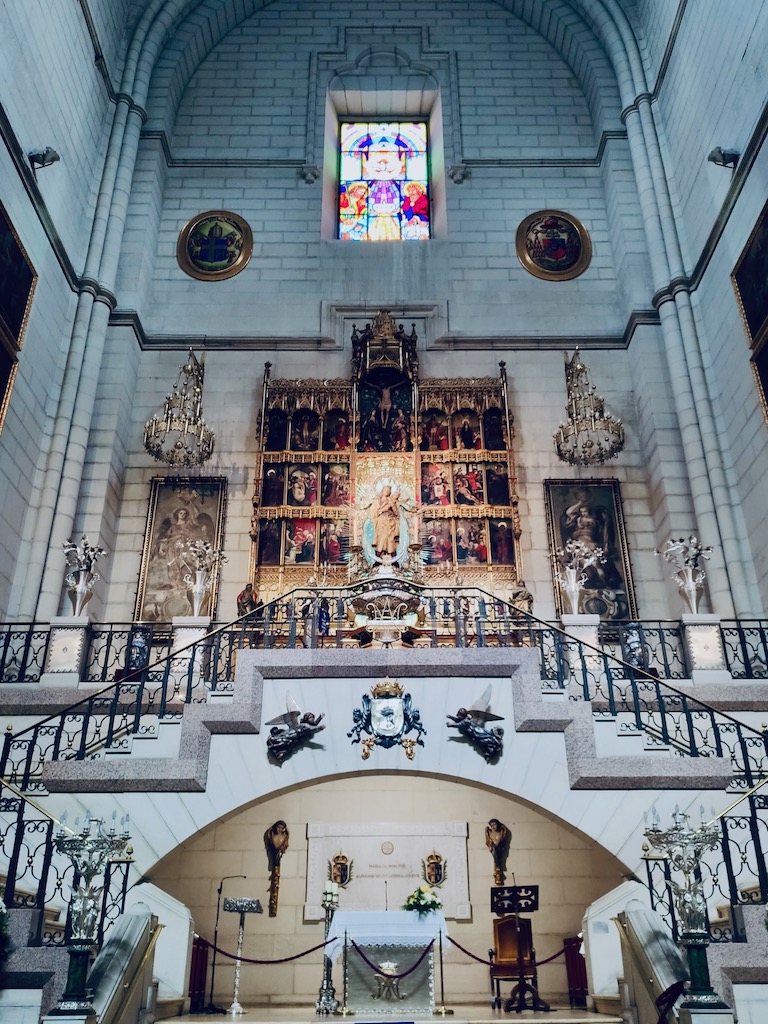

The statue is made of gilded and polychrome wood. The virgin rests on a baroque silver throne gifted by the city of Madrid during the reign of Philip IV. Two large candlesticks, also in silver and from the same period, stand on each side.
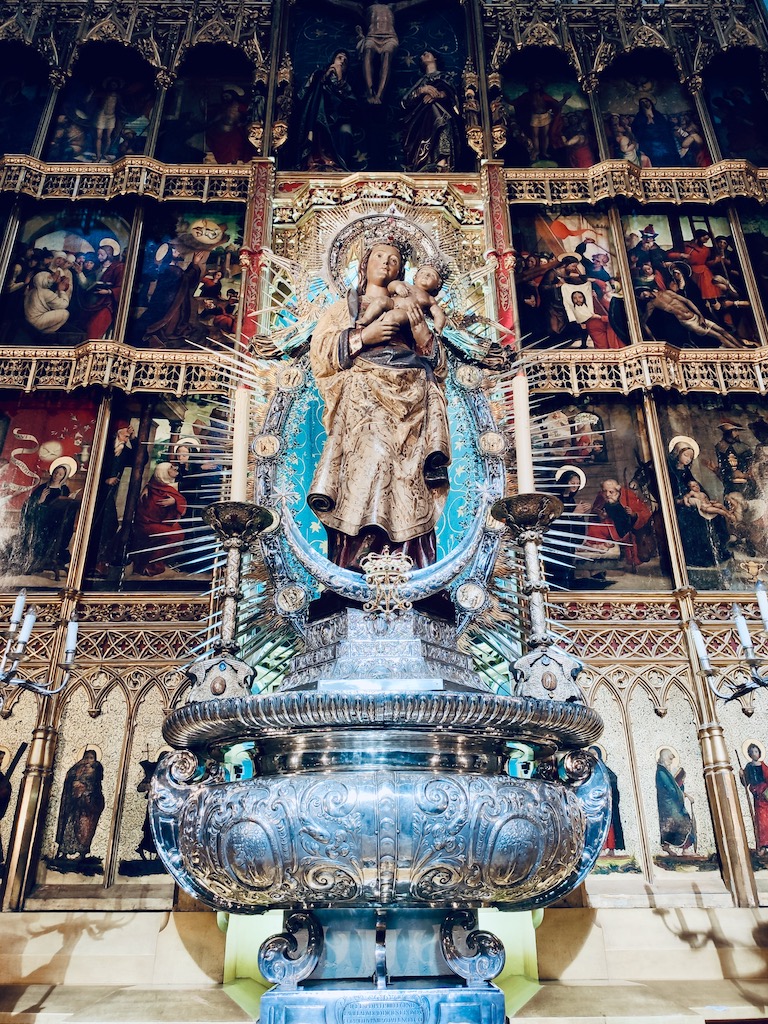

Behind us, we can admire the floor of the transept. It’s a combination of serpentine green marble from Granada and yellow polished travertine.
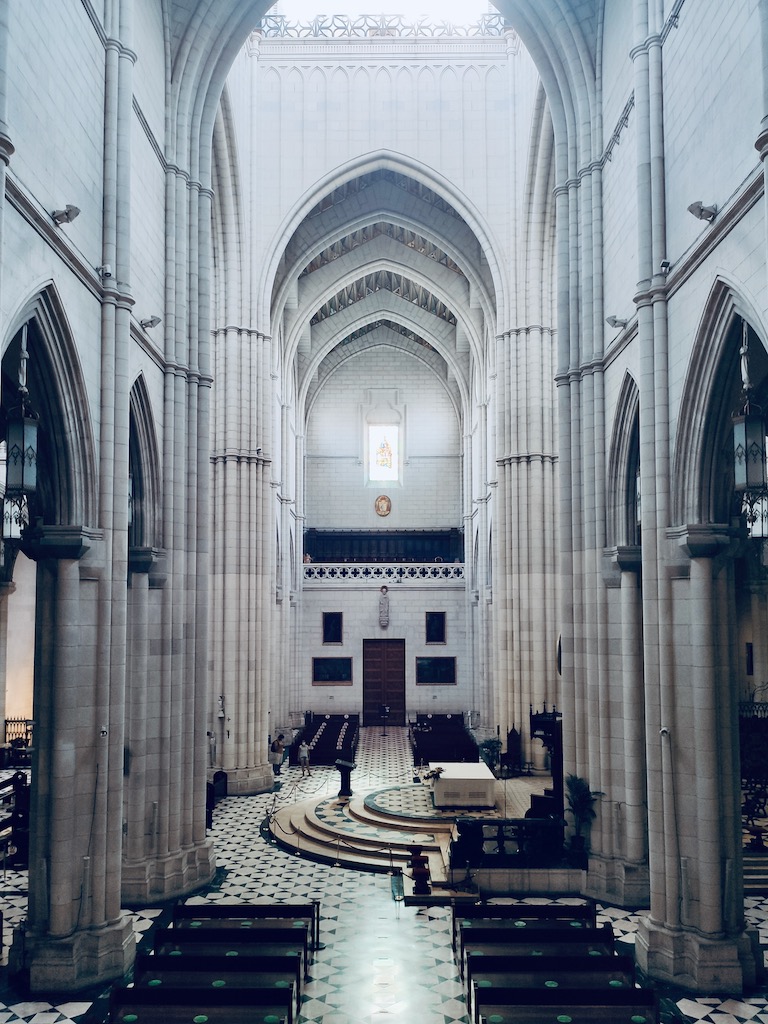

We are back in the nave and now face the majestic organ with its 71 rows of pipes.
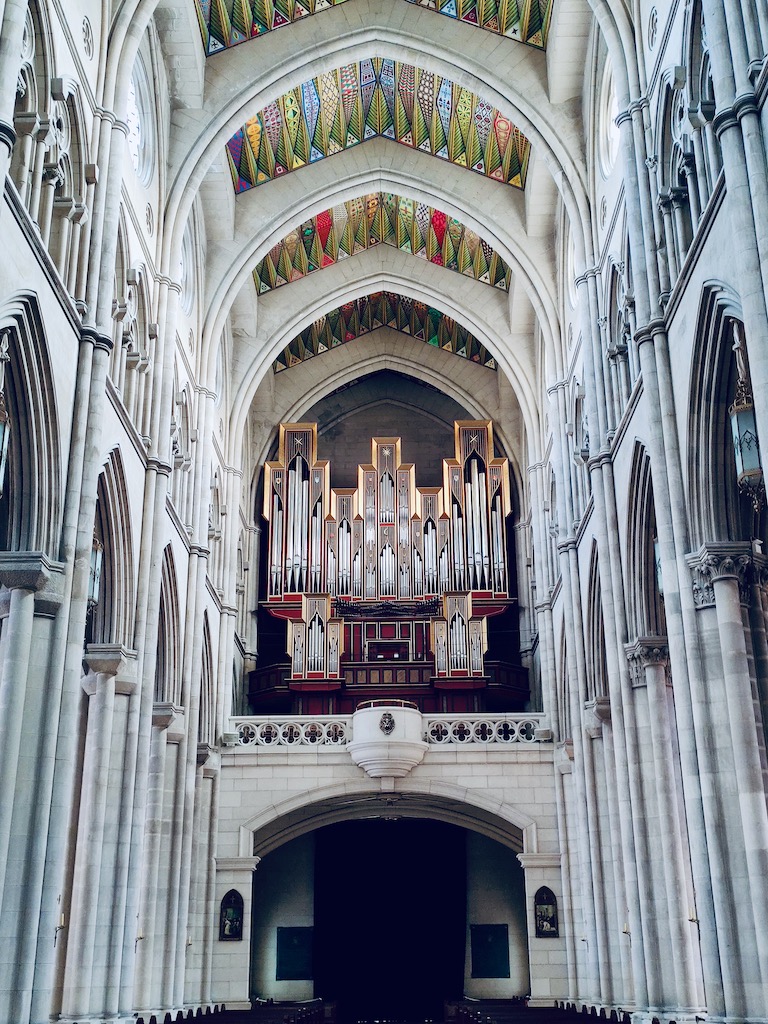

Looking up, we can see the vaults. The painter José Luis Galicia decorated them using bright colors as well as gold leaves.
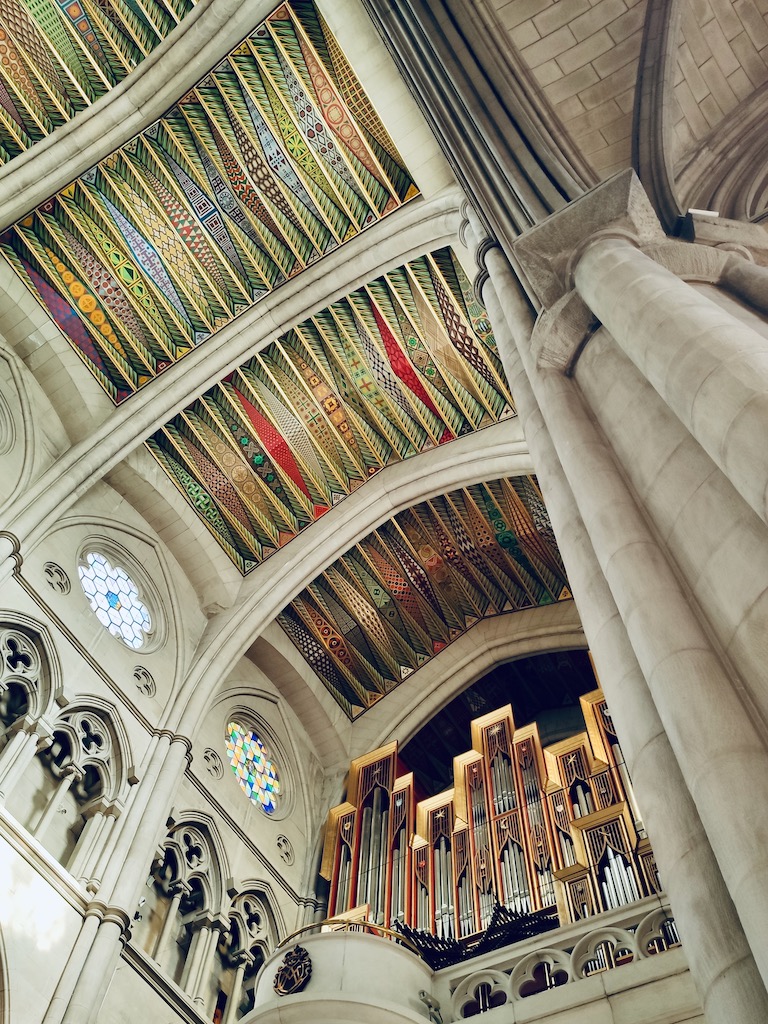

It was in this magnificent cathedral that the wedding of King Felipe IV and Queen Letizia took place on the 22nd of May 2004.
The Crypt
Francisco de Cubas also designed the crypt situated beneath the cathedral, both being the same size. The crypt of the Almudena Cathedral is the largest crypt in Spain.
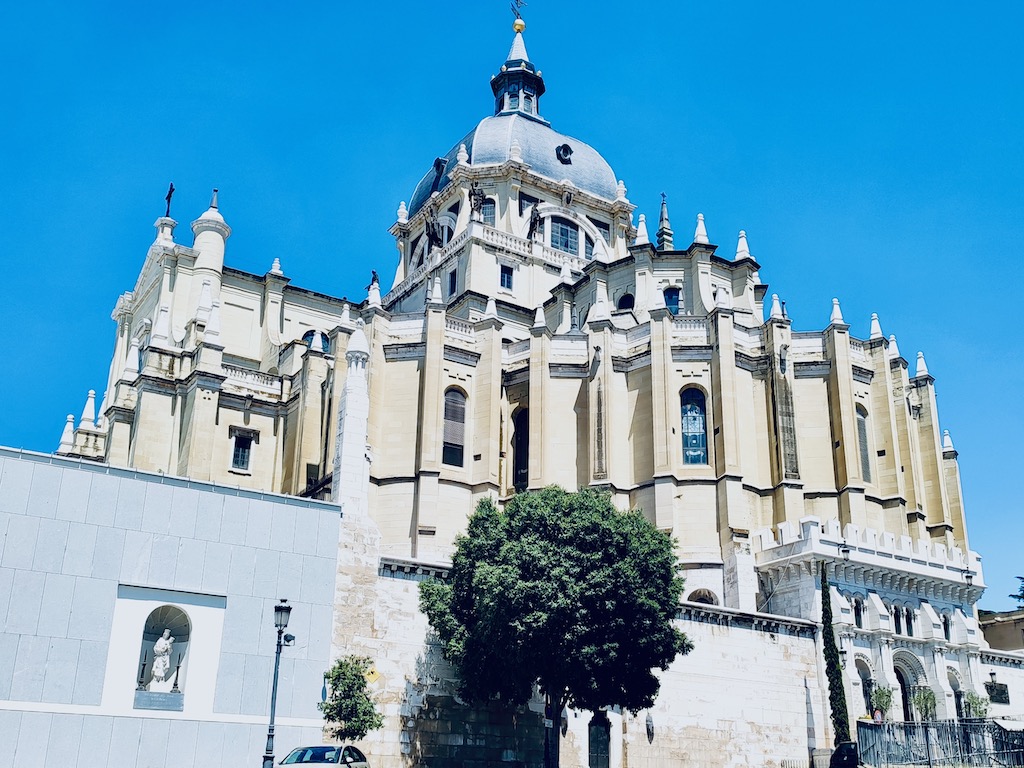

Its entrance, composed of three semi-circular arches, is on the south side of the cathedral.
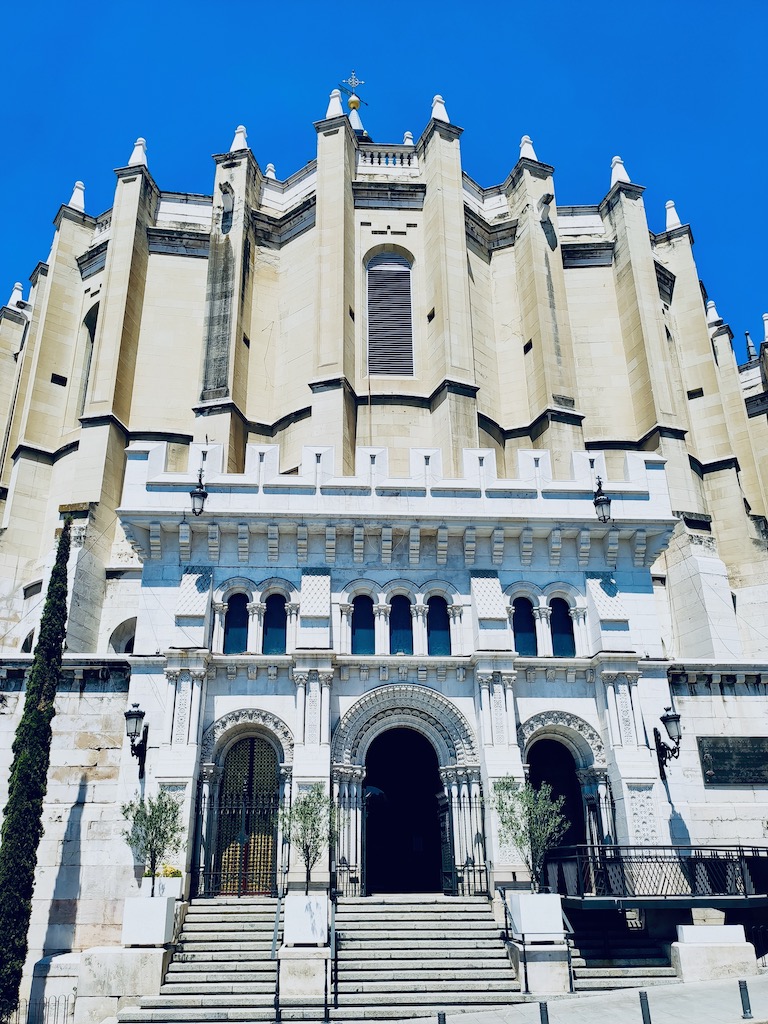

The Arab Wall
In front of the entrance is the Arab wall. Make a little detour to see it. These are what remains of the original wall of the city, built during the occupation of the Moors. Also, it has a nice garden.
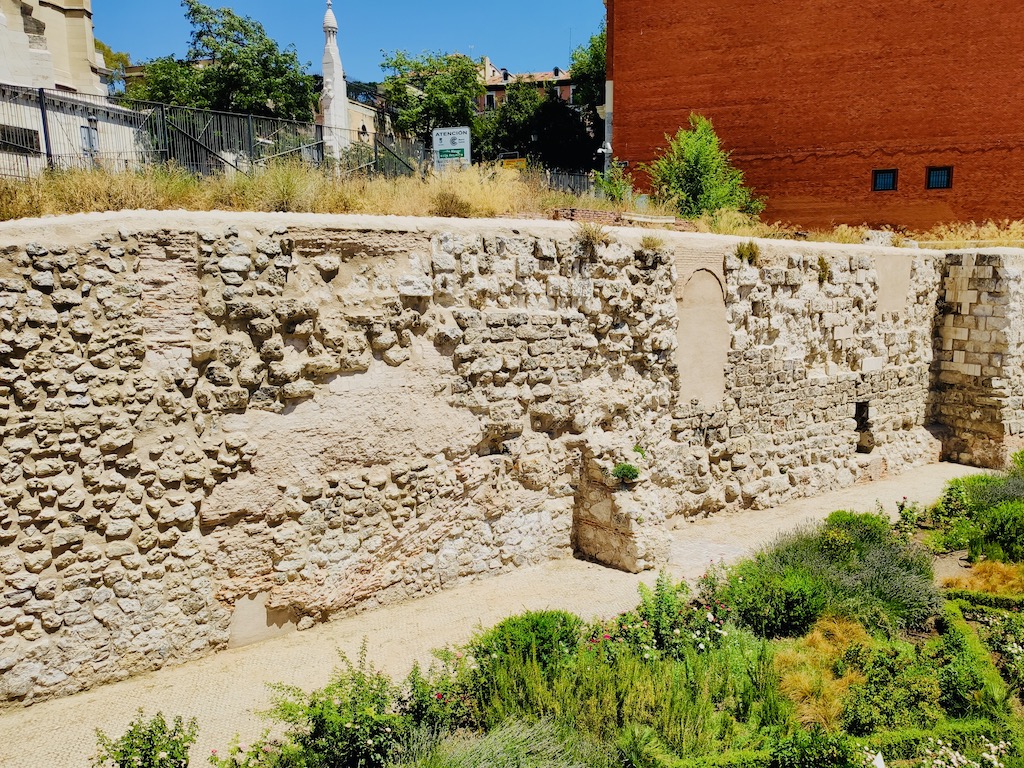

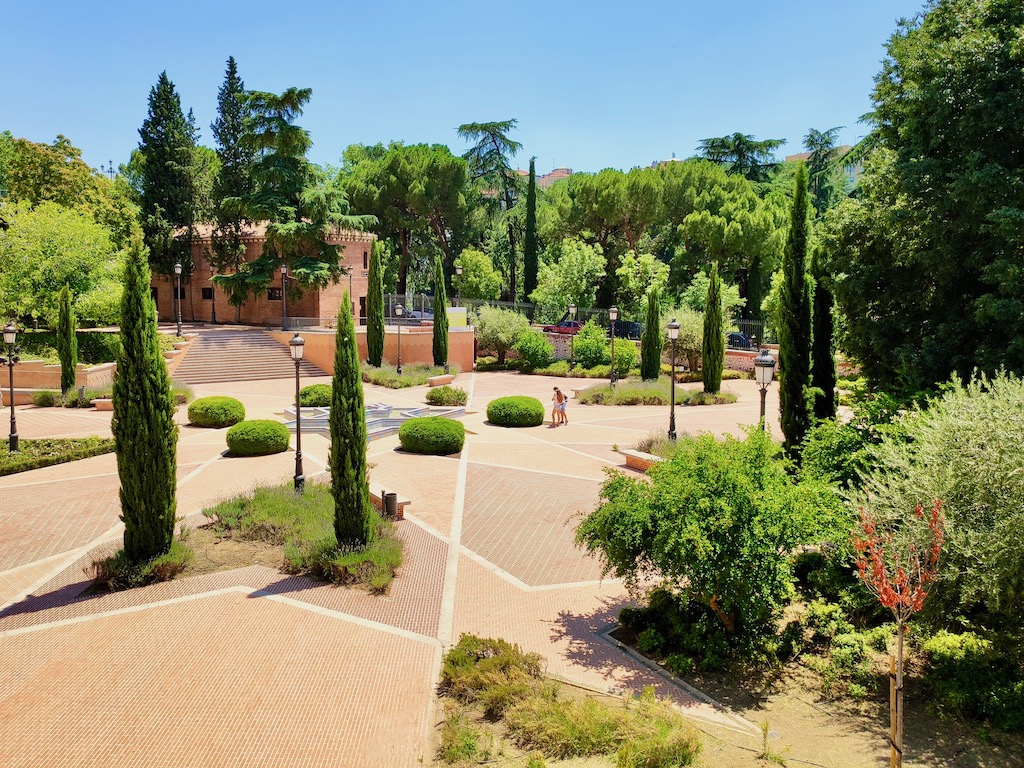

But back to the crypt — it is the resting place of some of Spain’s noblest families. Francisco de Cubas and Chueca Goitia, the cathedral’s two most important architects, rest here as well.
This neo-Romanesque church has more than 400 columns, each with different carved capitals. Additionally, there are sculptures that represent biblical characters and sceneries in nature. One can even find the symbol of Madrid, the bear and the strawberry tree.
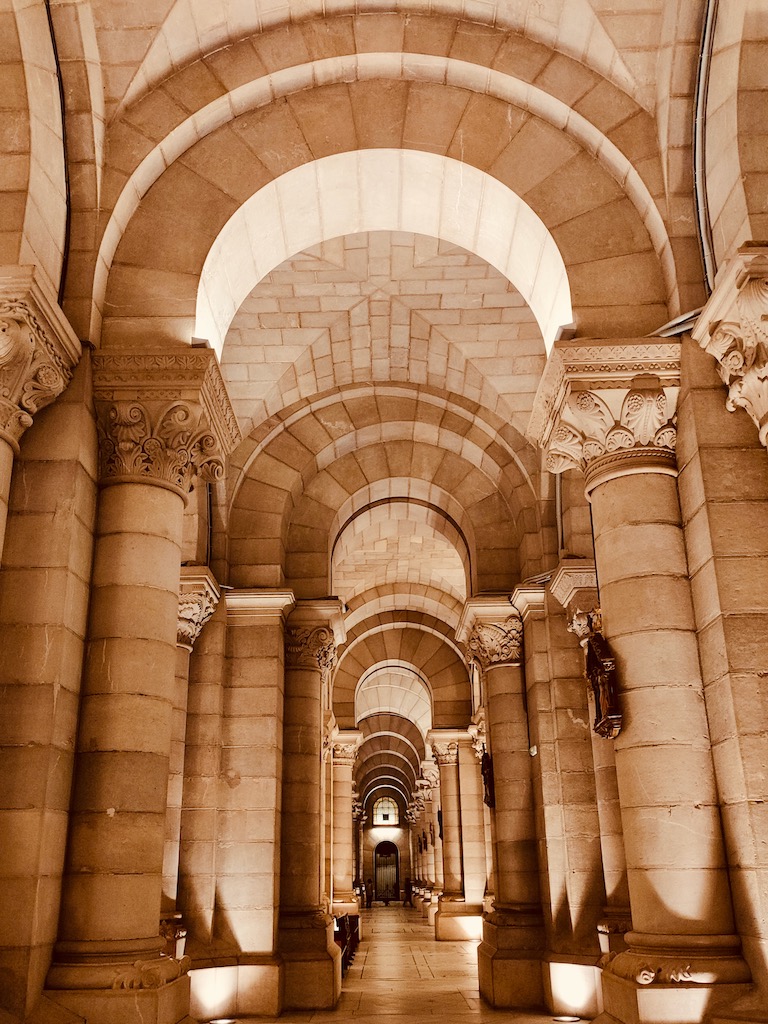

The nave and the main altar
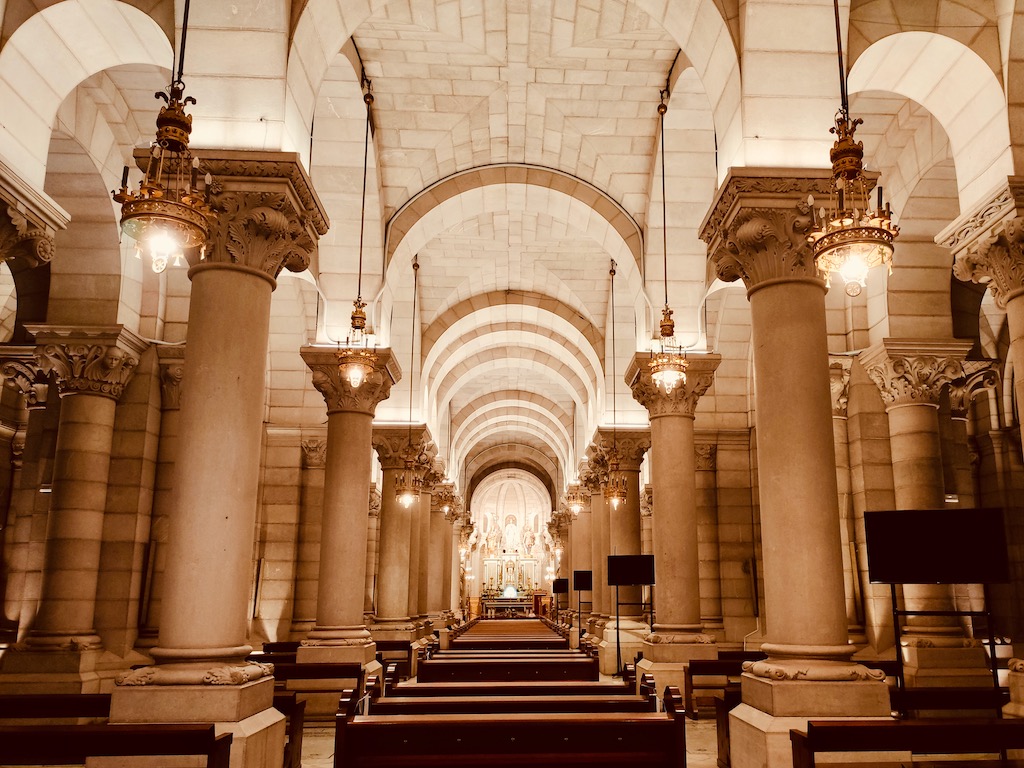

On the main altar is the statue of the Virgin of the Almudena, a replica of the one on display in the cathedral. Beside it is the Sacred Heart of Jesus and San Isidro Labrador.
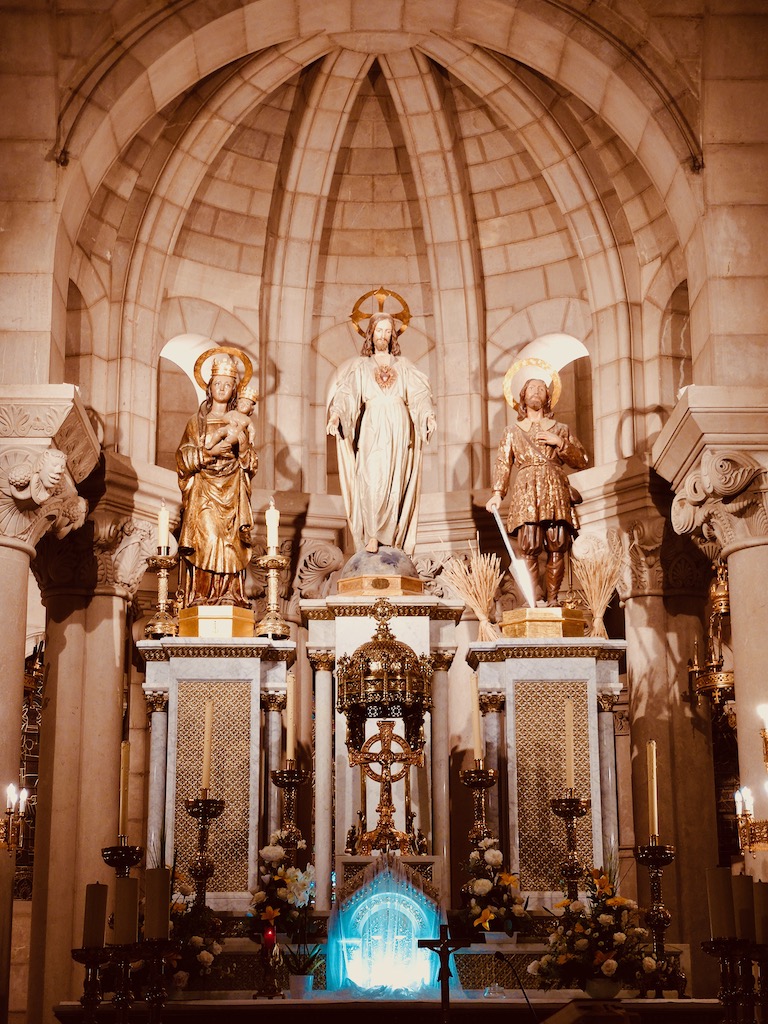

Isidore the Farm Laborer was a Spanish agricultural worker known for his piety towards the poor and animals. Canonized in 1622, he is the patron saint of farmers and Madrid. He has more than 400 miracles to his name!
The tombs
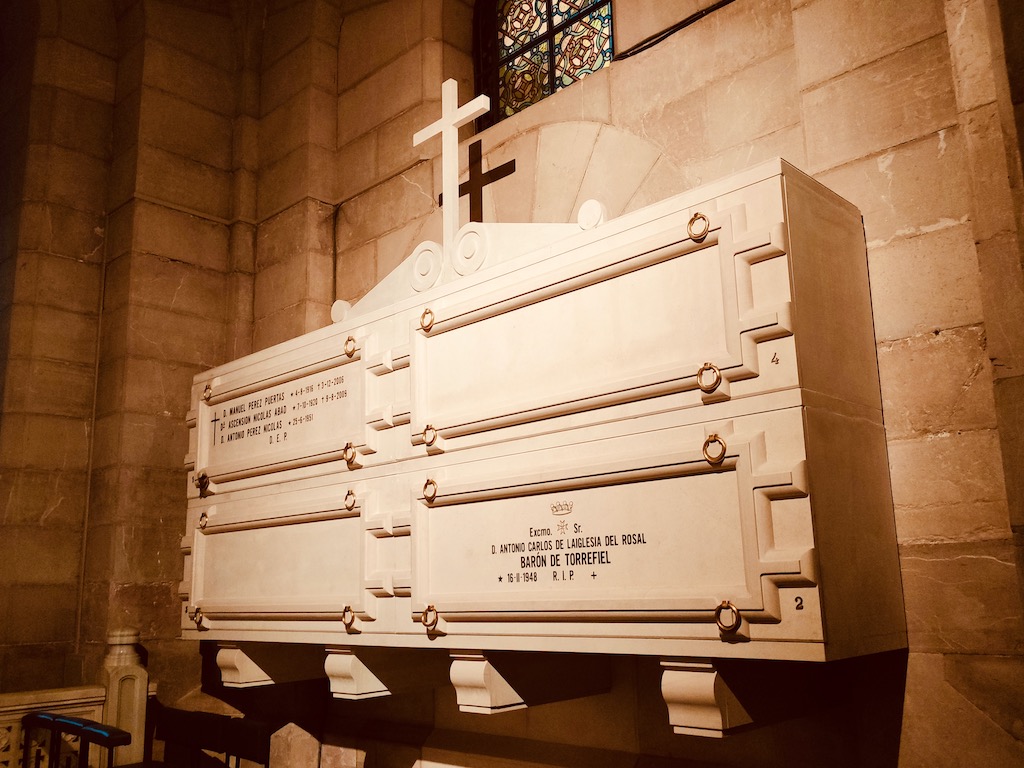

The crypt is a pantheon. There are more than a thousand people buried here. Under certain conditions, it is still possible at present to have this as one’s final resting place. All around the crypt, there are 20 chapels, each with its own stained-glass windows and decorated tombs.
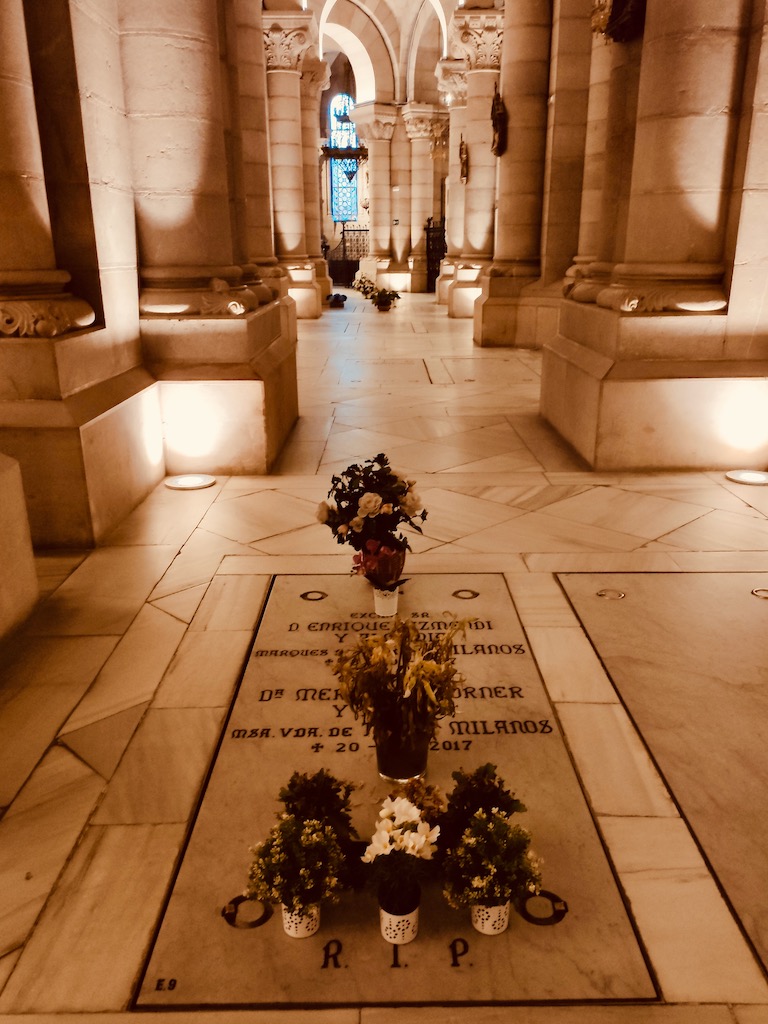

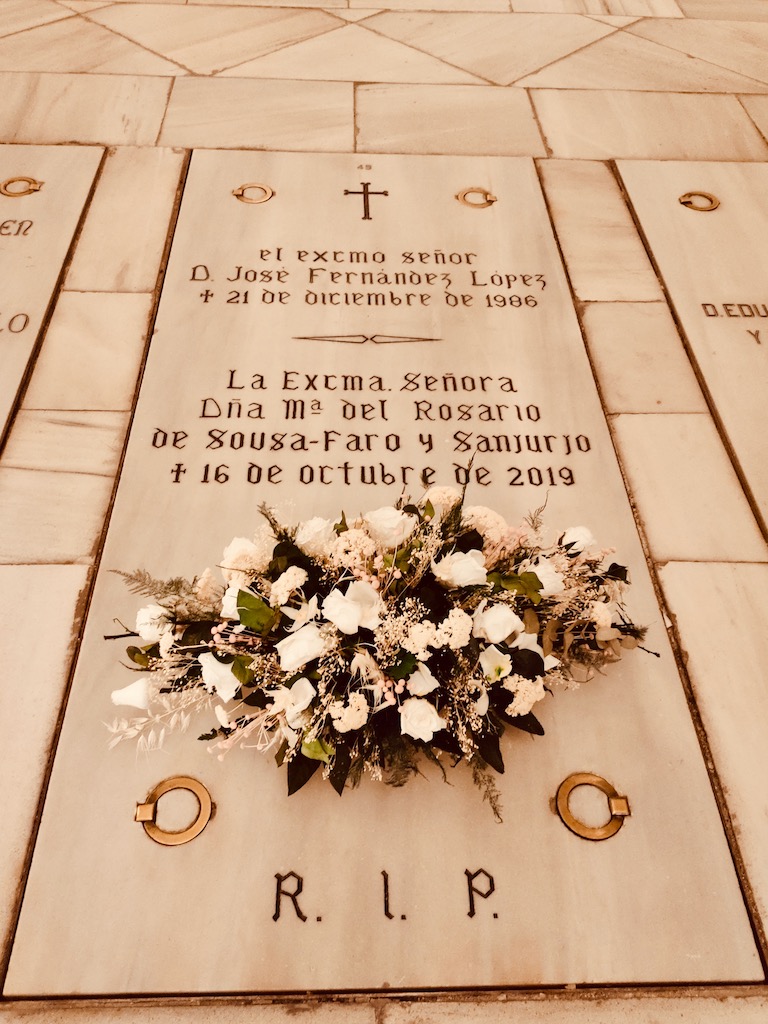

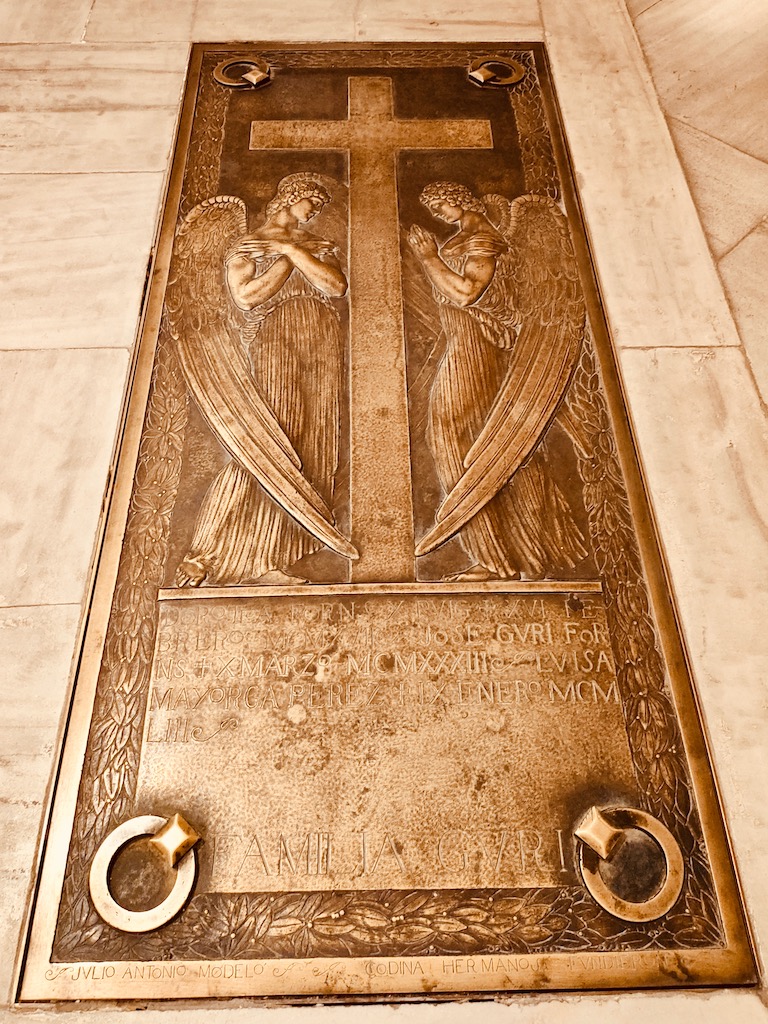

The graves are in the aisles on the ground, and I did my best to avoid walking on them. It was, I admit, a few times a little difficult!
Our Lady of the Lily
Here is the painting of Our Lady of the Lily, one of the most beautiful pieces of this crypt. This is probably the oldest image of the Virgin of the city.
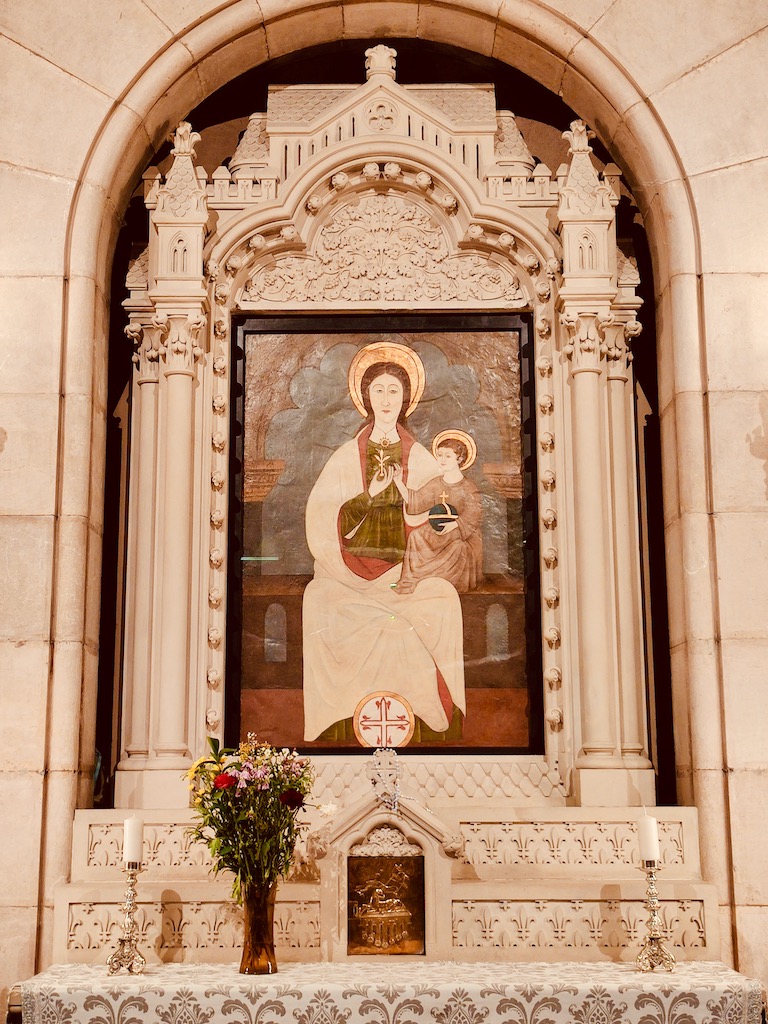

The mural comes from the original church of Santa Maria. The artist painted it in the 13th century on one of the church walls, so as not to leave the place without an image of the Virgin.
The painted wall served as an altarpiece and priests conducted masses in front of it. But later, the church built a proper altarpiece that covered the wall and soon the portrait was forgotten. Luckily, in 1623, sacristans moved the altarpiece to clean it and rediscovered the Lady of the Lily.
It was only because of the demolition of the church in 1868 that the painting was first moved to the Convent of the Religious Bernardas, and then, at its final location in the crypt in 1911.
Conclusion
I undoubtedly enjoyed the visit to this cathedral and its crypt. The beauty of the facades foreshadowed a great discovery for us, and I was not disappointed. I particularly liked the contrast between the two monuments— the sober crypt and the colorful cathedral. A must-do when you visit Madrid.
The entrance to the two monuments is free. There is, however, a donation of 2€ requested per person.



What an incredible history! I can’t believe the cathedral took 110 years to finish construction. The details on the gates are absolutely stunning.
Quite a long time to finish it indeed. But the result worth It.
I didn’t realise it was so new. You don’t imagine cathedrals being built in the last century. I won’t miss this in Madrid.
Yes, you’re right. It’s why its shape is quite different from the oldest cathedrals, and perhaps it explains also why the inside is so colourful.